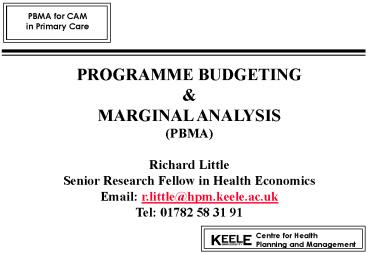PROGRAMME BUDGETING - PowerPoint PPT Presentation
1 / 17
Title: PROGRAMME BUDGETING
1
PROGRAMME BUDGETING MARGINAL ANALYSIS (PBMA) Ri
chard Little Senior Research Fellow in Health
Economics Email r.little_at_hpm.keele.ac.uk Tel
01782 58 31 91
2
Aim of Session
- To describe how the tool of PBMA can aid in more
robust systematic decision making in PCT
commissioning upon complementary and alternative
medicine.
3
Structure
- Why is PBMA useful?
- What is PBMA?
- PBMA Issues.
- Summary.
4
Why is PBMA Useful? (1) A World of Choices?
Education
Health
Defence
Environment
Transport
etc.
Community care
General Practitioner Services
Hospital Services
etc.
CHD
Mental Illness
Back Pain
etc.
Drug treatment
Surgery
CAM
etc.
etc.
5
Why is PBMA Useful? (2)Some Economics
- Decisions are taken upon competing demands for
the same resources. - The aim is to maximise the benefits from the
available resources, doing more of option A means
doing less of option B. - Economists call this the opportunity cost.
- This means choices have to be made,
prioritisation. - Individuals, no PBMA.
- NHS, PBMA.
6
Why is PBMA Useful? (3) Objectives of a Health
Care System?
- Within a system of publicly provided health care
two main objectives predominate - Efficiency
- maximising health benefits from the available
resources - Equity
- ensuring fairness in the distribution of those
benefits
7
Why is PBMA Useful? (4)
- PBMA is a tool that provides a systematic
framework for the decision maker. - The Marginal Analysis part of PBMA is firmly
grounded in economic theory.
8
What is PBMA? (1) Some basic steps.
- Establish perspective and define programme(s)
- Start within programmes
- Set programme objectives
- Identify current activity and spending on
programme - Obtain agreement on where changes could be made
- Evaluate these marginal changes
- Reallocate according to efficiency and equity
criteria.
9
What is PBMA? (2)Programme Budget (a).
- Depends upon the question?
- Identify the spend and activity by sub
programmes. - Whole PCT budget for different care groups,
disease groups. - One area of the budget e.g. the elderly, back
pain CAM may be one of several treatment
options.
10
What is PBMA? (2)Programme Budget (b).
11
What is PBMA? (2)Marginal Analysis (a)
- Costs and Benefits.
- Consider that a treatment is to be expanded into
a fixed budget - How much of the new treatment should be expanded?
- Which existing treatments should be reduced and
by how much?
12
What is PBMA? (2)Marginal Analysis (b)
- Marginal analysis compares the costs benefits
that are given up, with those of the expanded
treatment. - Efficiency benefits gained should exceed those
given up, resources redeployed s.t. equity. - New (less) resources, new (withdraw) treatments.
13
PBMA IssuesWhat to analyse?
- Deciding upon
- objective, programme perspective.
- Question.
- sub programmes.
- Commitment.
- Collect both costs benefits, PB is not enough,
must complete MA.
14
PBMA IssuesEstimating Costs
- What costs to measure?
- PB can be data hungry.
- Robust estimates of big cost drivers.
- Can tolerate less precise estimates for small
cost drivers. - Sources.
- Local estimates from budgets.
- Unit cost of Health Social Care, Personal
Social Services Unit. - Reference Costs, DoH.
- Drug costs, Drug Tariff, BNF.
- CAM costs?
15
PBMA IssuesEstimating Benefits
- What benefits to measure?
- Health gain, maintenance.
- Process.
- Who benefits, distribution, equity.
- Sources
- Evidence Published-(HoL Report) Local
estimates. - Experts estimation whose values.
- Modelling uncertainty.
16
Summary
- PBMA is based upon economic theory.
- Supports a systematic approach to decision
making. - Addresses both marginal costs and benefits.
- Would provide a framework for a PCT to determine
how much and what types of CAMs to fit into
existing treatments.
17
References
- Mitton C and Donaldson C, (2001) Twenty five
years of programme budgeting and marginal
analysis in the health sector, 1974-1999, Journal
of Health Services Research and Policy, 6 (4)
239-248. - Cohen D, (1994) Marginal analysis in practice
an alternative to need assessment for contracting
for health care, British Medical Journal, 309,
781-785.

